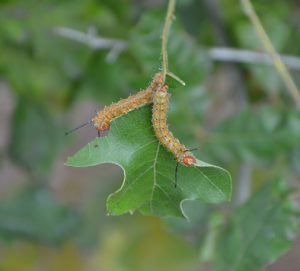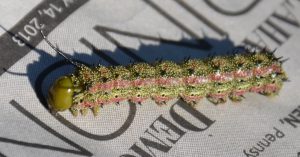
By Les Harrison
Wakulla County Extension Director
“The quality of mercy is not strained, it droppeth as the gentle rain from heaven,” so wrote the Bard of Avon, William Shakespeare in his classic play the Merchant of Venice.
The rains of 2017 in Wakulla County have been gentle, and not so gentle at time, but at least there has been plenty of them. The muddy roads and full ditches are mute testament to this bounty from above along with the lush growth of plants and trees.
The ample development of foliage county-wide had proven to be an unending buffet for all those insects and arthropods dependent upon a leafy diet. Their days are spent eating, moving to new dining options and producing replacements that can begin the cycle again.
Included among the ala-carte insect menu items are the plentiful oaks in north Florida. Unfortunately, for anyone who tarries too long beneath one of these oak trees which is, at the time, functioning as a caterpillar café will experience something else dropping from above.
Local oakworms are hard at work preparing to preserve their species for the waning days of autumn. Their numbers are building up in the favorable weather conditions of a wet summer which produces the nourishment to consume and support their reproductive efforts.
One of the active species frequently encountered is the Spiny Oakworms (Anisota stigma). This is one member of a moth genus which is actually a caterpillar not a true worm.
The difference between worms and caterpillars is substantial, but caterpillars are often misidentified as worms. Their tubular shape is a stage of life for a caterpillar which ultimately becomes a butterfly or moth.
The tubular shape is usually the development pinnacle of the worm’s life cycle. Most caterpillars tend to eat live vegetation while worms usually consume dead plants or animals which accelerats their decomposition and returns to the nutrients to the soil.
Healthy small oaks usually have enough vigor to leaf-out and survive the assault carried out by the Oakworms. Larger oaks have enough leaf producing capacity to out produce the caterpillars’ collective ability to eat.
In addition to the Spiny Oakworms, there are Red-humped Oakworms and Yellow Striped Oakworms which are native to Wakulla County. As their name implies, oak leaves are the nourishment of choice.
All the oakworms are about an inch in length with bristly hairs, especially in the case of the Spiny Oakworm. Colors and body patterns are the simplest way to identify the species in this genus.

These caterpillars are rarely seen alone in a tree. They are commonly found in colonies of 50 or more, each dining on a leaf and their droppings literally rain down on anything or anyone below them.
When threatened, they curl into a U shape and remain still. Predators are commonly confused by the behavior and seek other meal choices.
Home owners and landscape managers sometimes seek methods for controlling these caterpillars, but nature does the best job. Caterpillar population’s will peak in late summer to early autumn with birds, bats and others feasting on the defenseless moths before they can lay eggs.

The best advice is not to look up when under an oak tree as there may be an unpleasant surprise dropping.
Contact the UF/IFAS Wakulla County Extension Office at 850-926-3931 or https://blogs.ifas.ufl.edu/wakullaco/ to learn more about Oakworms in Wakulla County.
 0
0
